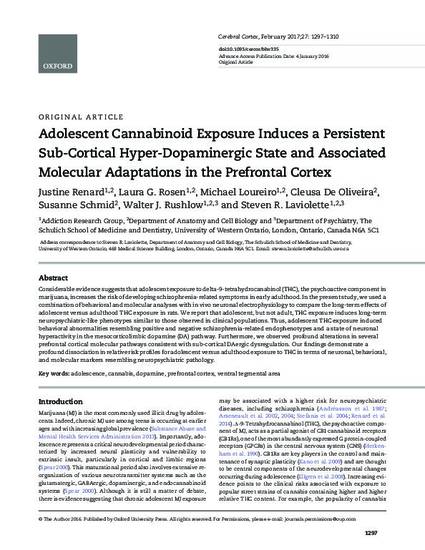
Considerable evidence suggests that adolescent exposure to delta-9-tetrahydrocanabinol (THC), the psychoactive component in marijuana, increases the risk of developing schizophrenia-related symptoms in early adulthood. In the present study, we used a combination of behavioral and molecular analyses with in vivo neuronal electrophysiology to compare the long-term effects of adolescent versus adulthood THC exposure in rats. We report that adolescent, but not adult, THC exposure induces long-term neuropsychiatric-like phenotypes similar to those observed in clinical populations. Thus, adolescent THC exposure induced behavioral abnormalities resembling positive and negative schizophrenia-related endophenotypes and a state of neuronal hyperactivity in the mesocorticolimbic dopamine (DA) pathway. Furthermore, we observed profound alterations in several prefrontal cortical molecular pathways consistent with sub-cortical DAergic dysregulation. Our findings demonstrate a profound dissociation in relative risk profiles for adolescent versus adulthood exposure to THC in terms of neuronal, behavioral, and molecular markers resembling neuropsychiatric pathology.
Available at: http://works.bepress.com/susanne-schmid/19/

This is a pre-copyedited, author-produced version of an article accepted for publication in [insert journal title] following peer review. The version of record:
Renard J, Rosen L, Loureiro M, DeOliveira C, Schmid S, Rushlow W, Laviolette S (2016) Adolescent Cannabinoid Exposure Induces a Persistent Sub-Cortical Hyper-Dopaminergic State and Molecular Disturbances in the Prefrontal Cortex Resembling Schizophrenia. Cerebral Cortex 27 (2):1297-1310
is available online at:
https://academic.oup.com/cercor/article-lookup/doi/10.1093/cercor/bhv335